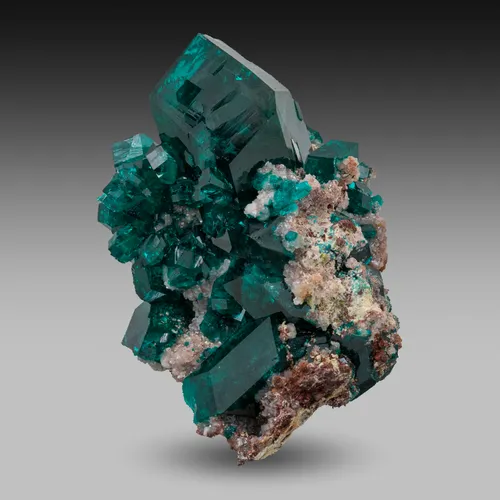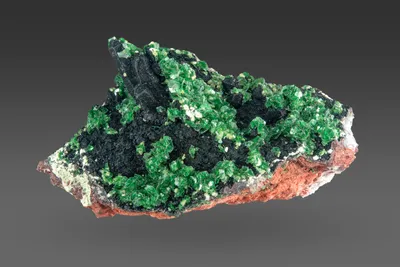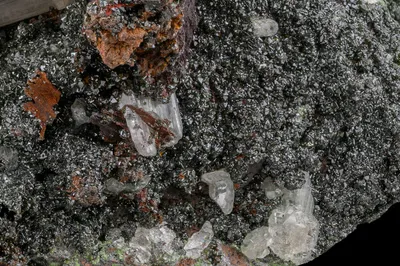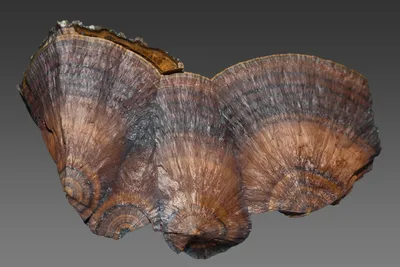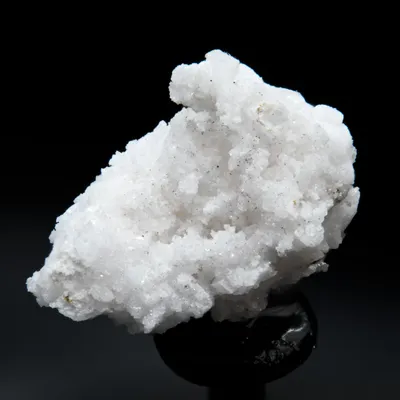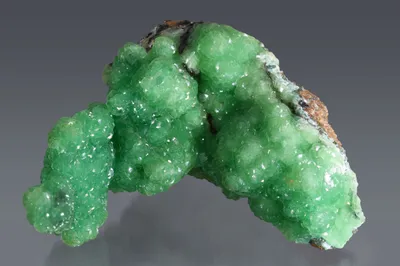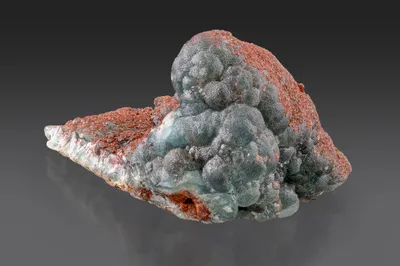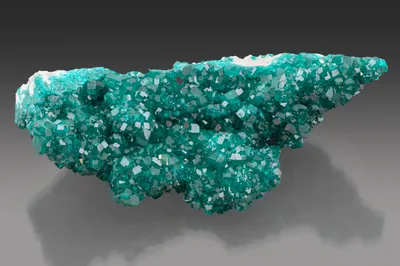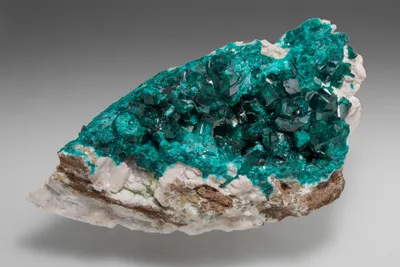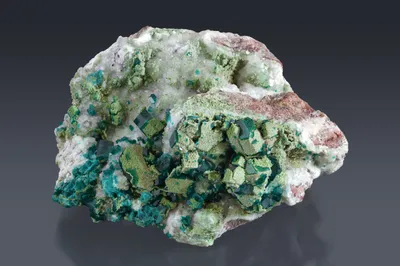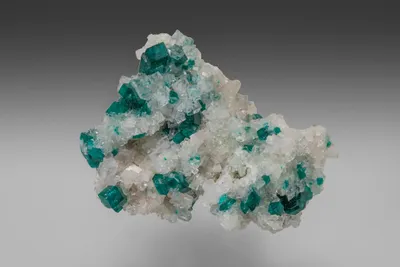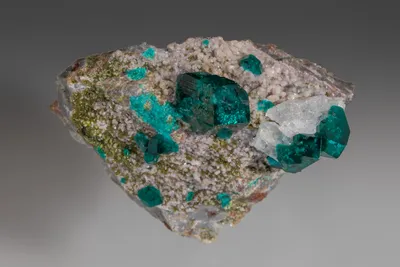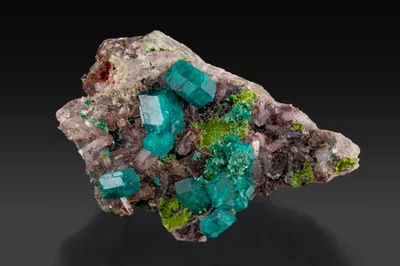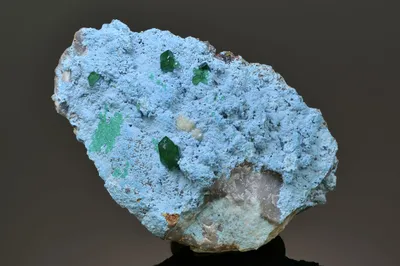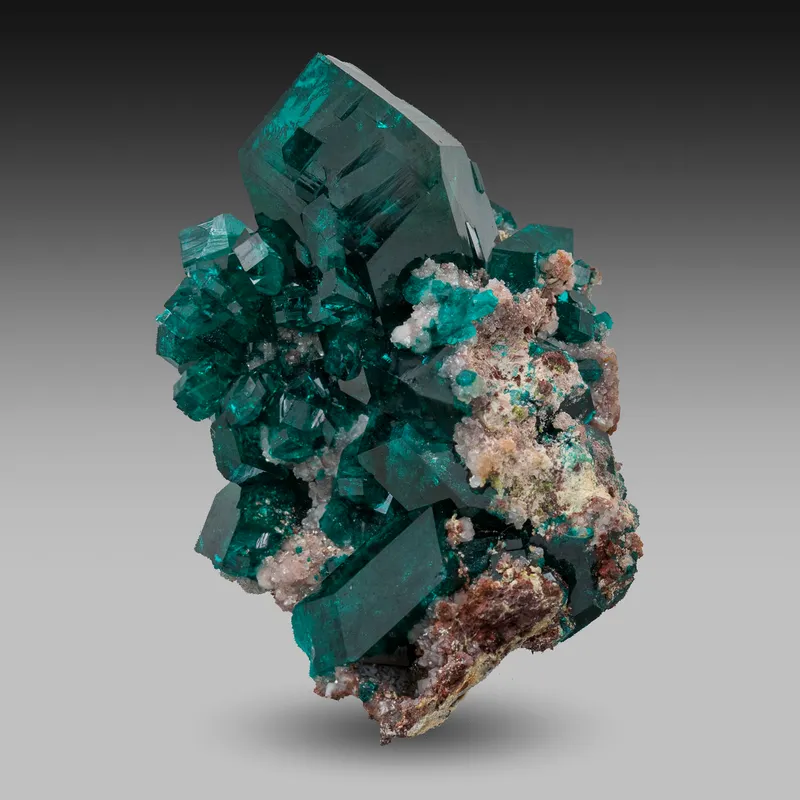
Image Credit: Malcolm Southwood
Mineral Species
Dioptase
Type Locality
No
Composition
Cu6Si6O18·6H2O
Crystal System
Trigonal
Status at Tsumeb
Confirmed
Abundance
Very common
Distribution
First (?), second and third oxidation zones
Paragenesis
Supergene
Entry Number
Species; TSNB107
General Notes
Dioptase is generally absent from early (pre-WWII) collections of Tsumeb minerals, suggesting that it was extremely rare (or possibly even absent) in the first oxidation zone. Klein (1938) considered it "… a great rarity" at Tsumeb and only to a depth of 100 metres (4 Level).
Yet the notion that dioptase was abundant in the first oxidation zone persists. Jones (1985) commented that "Although dioptase was mined in the upper part of the oxide zone a half-century ago it was not until the 1970s that it made a major impact on the collector world." In fact, there is scant evidence for any significant dioptase discoveries at Tsumeb before the 1960s. More recently Wilson (2022), comparing Tsumeb with mining claims in the Kaokoveld, wrote that "… at Tsumeb the original surface zone (the historically famous "Green Hill") had been mostly malachite and dioptase as well." If this were the case, surely the presence of dioptase would have been recorded and specimens would have been preserved, but there are none!
Strunz et al. (1958) and Bartelke (1976) listed dioptase as a first oxidation zone mineral, possibly based on Klein’s (1938) commentary, but the potential for early specimens attributed to Tsumeb to have originated, in fact, from the nearby Guchab Mine, leaves much room for doubt.
The abundance of dioptase in the second oxidation zone is related both spatially and genetically to the preponderance of hypogene silicification of the ore body at that depth. Lombaard et al. (1986) note that:
"Dioptase is present in appreciable amounts in the lower [second oxidation] zone within areas of intense silicification and ferruginization associated with drusy calcite and dolomite between 29 and 33 levels and on 35 Level."
The "dioptase zone" coincides with the intersection of the North Break Zone with this silicified portion of the primary ore body.
From the deeper levels (i.e. second and third oxidation zones), American dealer Charles Key estimated that the value of dioptase specimens recovered from Tsumeb exceeds the value of all of the other specimen minerals combined (Key, 1996).
Major finds of specimen-quality dioptase included the following:
- On 30 Level: ".... miners encountered numerous pockets, some very large, that contained thousands of specimens of breathtakingly beautiful, dark emerald-green dioptase" (Key 1996).
- On 32 Level, Zero Stope produced some of the best dioptase on contrasting white calcite matrix (Clive King, pers. comm. to M. Southwood, 2014).
- On 33 Level, dioptase supplanted by gemmy crystals of cerussite, both on white calcite, was discovered in 1975 (Key 1977).
- On 44 Level, in the third oxidation zone dioptase was found with malachite and conichalcite while another third oxidation zone discovery featured dioptase with wulfenite (Gebhard, 1999).
Clive King (senior mine geologist with TCL in the 1980s) recalled that:
"When I first arrived in Tsumeb as underground geologist, dioptase was coming out from 30 level - S110 Stope and E19. Most of the crystals were small and sugary and were mainly on a red earthy matrix. Zero Stope - 32 Level came back on stream in the early '80s and this was the stope where I think some of the best dioptase ever came from - especially those on a white calcite base. Zero Stope was the last stope before the crown pillar - so once this had been mined out - the area was abandoned until many years later." (Clive King, pers. comm. to M. Southwood, March 2014.)
Dioptase from Tsumeb is a deep, very slightly bluish, emerald green in colour, transparent, and with a bright, vitreous to sub-adamantine lustre. Accurate photographic representation of the colour is notoriously difficult.
The majority of Tsumeb dioptase crystals comprise just two crystallographic forms: the hexagonal prism {110}, and the rhombohedron {021}. Occasionally other crystallographic forms make an appearance, but Tsumeb dioptase is generally not form-rich. A few crystals have a narrow bevel between the prism and the rhombohedron (probably {131}) and somewhat rarely, a pinacoid {001}, is developed which can contribute to a pseudo-cubic appearance. Short prismatic crystals are very typical of Tsumeb dioptase, in contrast with the longer prismatic habit that is generally associated with the dioptase localities in the Kaokoveld region of northern Namibia (Bowell et al. 2013).
Flawless, gemmy crystals of dioptase to 5 mm are considered very common at Tsumeb.
Pinch and Wilson (1977) noted that "Crystals have been found to 5 cm in size, and crystals 1 cm in size are fairly common." Kostov and Kostov (1999) made the highly dubious claim that "Large dioptase crystals measuring up to 9 cm are known from Tsumeb, Namibia".
Gebhard (1999) describes occurrences of dioptase in the third oxidation zone as follows:
"It was the 44 level where about 30 specimens of crystals [of dioptase] up to 1 cm were found. These crystals have a different appearance, perhaps due to the association with malachite and conichalcite. Probably the strangest combination of colours was also found in the third oxidation zone; a few specimens of extremely chromate-yellow wulfenite crystals up to 1 cm sprinkled on emerald-green dioptase."
Keller (1977a) noted that dioptase at Tsumeb occurs "almost exclusively in the country rock…" and that it is "…only rarely associated with other secondary minerals". He placed dioptase in one of the subdivisions of his "Type I" paragenetic sequences (i.e., sequences forming at relatively high pH values) as follows:
I/9: dolomite >> duftite >> plancheite >> dioptase(i) >> calcite >> dioptase (ii)
Associated Minerals
azurite; bayldonite; calcite; cerussite; chrysocolla; conichalcite; cotunnite; cuprite; dolomite; duftite; fornacite (?); goethite; malachite; mimetite; minrecordite; molybdofornacite; mottramite; plancheite; quartz; shattuckite (?); smithsonite; tenorite; willemite; wulfenite
